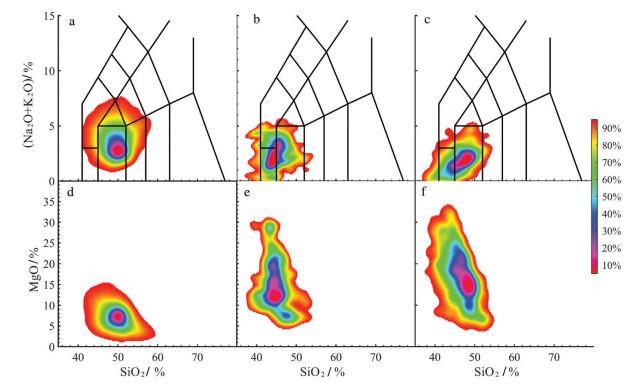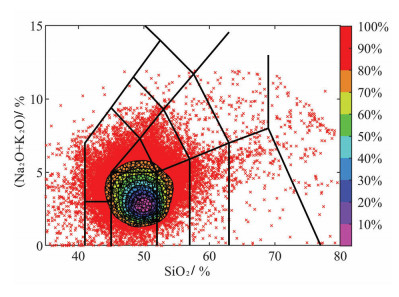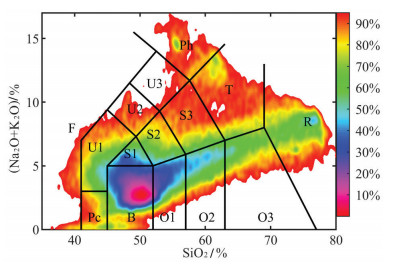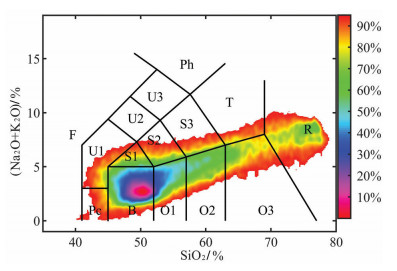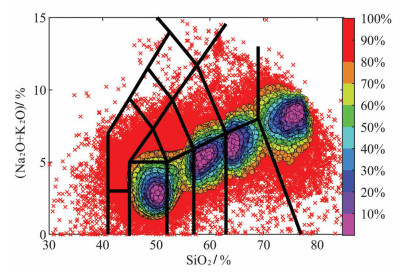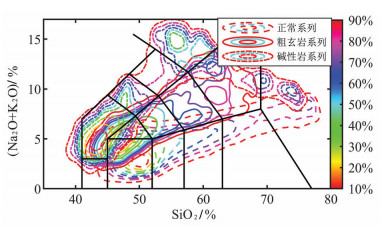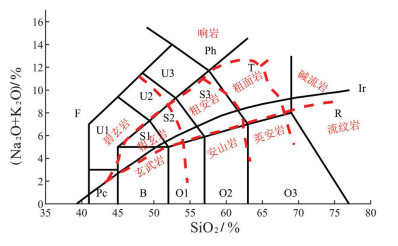The deficiencies and possible solutions of TAS classification in the context of big data
-
摘要:
火山岩TAS分类是国际地质科学联合会在1989年第28届国际地质大会上通过的,迄今已经40年了。该分类对推进岩石学和地球化学的研究起了积极的作用,规范了岩石(尤其火山岩)的命名,方便了学术界的交流。但是,不能不承认,早先的研究,由于分析方法、分析技术以及数据量的限制,是存在某些局限性的。现在,全球已积累了海量的数据,应当有条件对火山岩的分类做一个新的探讨了。文中讨论了TAS分类的初衷、分类的原则及存在的问题,推出了新的TAS分类方案。早先的分类一共划分了15个岩区,新的方案压缩为10个,其中9个保留了早先的命名,新增一个碱流岩区。新的TAS图最大的变化在碱性岩系列,在新的TAS图中,碱性岩系列呈"人"字形分布,把粗玄岩系列封闭起来,弥补了早先的TAS分类在酸性岩部分的不足,还发现TAS图理论上可能存在的一些问题。本文的探讨是初步的,只是抛砖引玉,希望能够引起学术界的关注,开启利用大数据方法对TAS分类的新的研究。
Abstract:The TAS diagram, which is widely used in academia, is a classification scheme for volcanic rocks approved by IUGS in 1989. This classification has been active in advancing the research on petrology and geochemistry, regulating the naming of rocks (especially volcanic rocks) and facilitating the exchange of academia. However, it cannot be denied that earlier studies had some limitations due to analytical methods, analytical techniques and data volume limitations. Now that the world has accumulated a huge amount of data, researchers should have the conditions for making new discussion on the classification of volcanic rocks. In this study, the authors have developed a new TAS classification scheme for volcanic rocks using a probability density function. The original TAS diagram defines 15 root names, among which 9 are preserved in this paper. With the addition of one new root name, the authors define a total of 10 root names. The biggest change in the new TAS diagram is in the alkaline rock series. In the new TAS diagram, the trachybasalt series is closed up, thus making up for the earlier TAS classification in the acidic rock part of the deficiency. The authors have also found that the TAS diagram may have some problems. The classification scheme presented in this study is subject to further discussions and tests.
-
Key words:
- TAS diagram /
- volcanic rocks /
- classification /
- rock natural compositions /
- rock natural distributions /
- big data /
- all data
-

-
图 1 TAS火山岩分类命名图[20]
Figure 1.
图 5 全球正常系列火山岩数据分布趋势图(图中代号同图 1)
Figure 5.
-
[1] Iddings J P. Origin of Igneous Rocks[M]. Bull. Phil. Soc. Washington, 1892, 12: 89-213.
[2] Chayes F. Alkaline and subalkaline basalts[J]. Am. Jour. Sci., 1966, 264:128-145. doi: 10.2475/ajs.264.2.128
[3] Streckeisen A, Le Maitre R W. A chemical approximation to the modal QAPF classification of the igneous rocks[J]. N. Jb. Miner. Abh., 1979, 136:169-206. http://geosphere.geoscienceworld.org/lookup/external-ref?access_num=1980021909&link_type=GEOREF
[4] Fitton J G. Upton B G J. Alkaline Igneous Rocks[M]. Geol. Soc. Spec. Publ., 1987.
[5] Irvine T N, Baragar W R A. A guide to the chemical classification of the common volcanic rocks[J]. Can. J. Earth Sci., 1971, 8, 523-48. doi: 10.1139/e71-055
[6] Le Maitre R W. Some problems of the projection of chemical data into mineralogical classifications[J]. Contr. Miner. Petrol., 1976, 56:181-9. doi: 10.1007/BF00399603
[7] Le Martre R W, Bateman P, Dudek A. A Classification of Igneous Rocka and Glossary of Terms[M]. Oxford:Blackwell, 1989.
[8] Kuno H. High-alumina basalt[J]. J. Petrol., 1960, 1:121-145. doi: 10.1093/petrology/1.2.121
[9] Kuno H. Lateral variation of basalt magma types across continental margins and island arcs[J]. Bull. Volcanol, 1966, 29:195-222. doi: 10.1007/BF02597153
[10] Le bas M J, Le Maitre R W, Streckeisen A, et al. A chemical classification of volcanic rocks based on the total alkali-silica diagram[J]. J. Petrol., 1986, 27:745-750. doi: 10.1093/petrology/27.3.745
[11] Middlemost E A K. A contribution to the nomenclature and classification of volcanic rocks[J]. Geol. Mag., 1980, 117:51-7. doi: 10.1017/S0016756800033094
[12] Murray J W. A Guide to Classification in Geology[M]. Chichester Ellis Horwood Ltd, 1981.
[13] Rollison H R. Using Geochemical Data: Evaluation, Presentation, Interpretation[M]. Longman Scientific and Technical, New York, 1993.
[14] 王碧香.国际火成岩分类命名研究现状[J].地质科技情报, 1990, (4):30-31. http://www.cqvip.com/Main/Detail.aspx?id=229448
[15] Cox K G, Bell J D, Pankhurst R J. The Interpretation of Igneous Rocks[M]. London:George Allen & Unwin, 1979.
[16] Carmichael I S E, Turner F J, Verhoogen J V. Igneous Petrology[M]. Department of Geology and Geophysics, Berkeley:University of California, 1982.
[17] 邓晋福, 刘翠, 冯艳芳, 等.关于火成岩常用图解的正确使用:讨论与建议[J].地质论评, 2015, 61(4):717-734. http://d.old.wanfangdata.com.cn/Periodical/dzlp201504002
[18] 都城秋穗, 久城育夫.岩石学[M].北京:科学出版社, 1984:1-344.
[19] Wilson M. Igneous Petrogenesis[M]. London:Unwin Hyman. 1989.
[20] Le Maitre R W. A proposal by the IUGS Subcommission on the Systematics of Igneous Rocks for a chemical classification of volcanic rocks based on the total alkali silica (TAS) diagram[J]. Australian J. Earth Sci., 1984, 31:243-255. doi: 10.1080/08120098408729295
[21] MacDonald G A, Katsura T. Chemical compositions of Hawaiian lavas[J]. J. Petrol., 1964, 5:83-133. http://www.wanfangdata.com.cn/details/detail.do?_type=perio&id=ee77d8f3b62c0e77c8fe6b94a1fe868d
[22] MacDonald G A. Composition and origin of Hawaiian lavas[C]//Coats R R, Hay R L, Anderson C A. Studies in volcanology: a memoir in honour of Howel Willims. Geol. Soc. Am. Mem., 1968, 116: 477-522.
[23] 张旗, 周永章.大数据正在引发地球科学领域一场深刻的革命——《地质科学》 2017年大数据专题代序[J].地质科学, 2017, 52(3):637-648. http://www.wanfangdata.com.cn/details/detail.do?_type=perio&id=dzkx201703001
[24] Trigor W E. Speiziclle Petrographic der Eruptivgesteine[M]. Berlin, 1935.
[25] Rittmann A. Stable Mineral Assemblages of Igneous Rocks[M]. Heidelberg:Springer-Verlag, 1973.
[26] Streckeisen A. To each plutonic rock its proper name[J]. Earth-Sci. Rev., 1976, 12:1-33. doi: 10.1016/0012-8252(76)90052-0
[27] Hatch F H, Wells A K, Wells M K. The Petrology of the Igneous Rocks[M]. Thomas Murby, London, 1972.
[28] De La Roche H, Leterrier P, Grandclaude P, et al. A classification of volcanic and plutonic rocks using the R1-R2 diagram and major element analyses. Its relationships with current nomenclature[J]. Chem. Geol., 1980, 29:183-210. doi: 10.1016/0009-2541(80)90020-0
[29] Zancttin B. Proposed new chemical classification of volcanic rocks[J]. Episodes, 1984, 7:19-20. doi: 10.18814/epiiugs/1984/v7i4/003
[30] Streckeisen A. Classification and nomenclature of volcanic rocks, lamprophyres, carbonatiets, and melilitic roeks, recommendations and suggestions of the IUGS commission on the systmeaties of igneous roeks[J]. Geology (Boulder), 1979, 7:331-335. doi: 10.1130/0091-7613(1979)7<331:CANOVR>2.0.CO;2
[31] Frolova T I, Petrova M A. The classification diagram of effusive rocks[C]//IUGS Subcommission, 18th circular, Contrib., 1974, 39: 25-30.
[32] Peccerillo A, Taylor S R. Geochemistry of Eocene calc-alkaline volcanic rocks from the Kastamonu area, northern Turkey[J]. Contrib. Mineral. Petrol., 1976, 58:63-81. doi: 10.1007/BF00384745
[33] 邓晋福.火成岩系列划分的回顾与当代含义[J].岩石矿物学杂志, 1991, 10(1):37-42.
[34] 葛粲, 顾海欧, 汪方跃, 等.基于数据密度确定分布区域的方法:以TAS图解分析为例[J].地质科学, 2018, 53(4):1240-1253. http://d.old.wanfangdata.com.cn/Periodical/dzkx201804006
[35] 张旗, 李达周, 张魁武.横断山区镁铁-超镁铁岩[M].北京:科学出版社, 1992.
[36] 张旗, 王焰, 熊小林, 等.埃达克岩和花岗岩:挑战与机遇[M].北京:中国大地出版社, 2008.
[37] Streckeisen A. Classification and nomenclature of volcanic rocks, lamprophyres, carbonatites and melilitic rocks[J]. N. Jb. Miner. Abh., 1978, 134:1-14.
[38] 王金荣, 陈万峰, 张旗. MORB数据挖掘:玄武岩判别图反思[J].大地构造与成矿学, 2017, 41(2):420-431. http://d.old.wanfangdata.com.cn/Periodical/ysxb98201703023
[39] Carmichael I S E, Turner F J, Verhoogen J. Igneous Petrology[M]. New York:McGraw-HiU, 1974.
[40] Jiao S T, Zhang Q, Ge C et al. Distribution of Picrite Basalt on TAS and the Boundary between Basic and Ultrabasic Rocks: Research and Discovery of Global Volcanic Rock Data (in press).
[41] Yoder H S Jr, Tilley C E. Origin of basalt magmas:an experiment study of natural and synthetic rock systems[J]. J. Petrol., 1962, 3:342-532. doi: 10.1093/petrology/3.3.342
[42] 查瓦里茨基A H.火成岩[M].北京:地质出版社, 1958.
[43] 曾广策, 邱家骧.碱性岩的概念及其分类命名综述[J].地质科技情报, 1996, 15(1):31-37. http://www.wanfangdata.com.cn/details/detail.do?_type=perio&id=QK199600970946
[44] 赵振华.富碱侵入岩——窥探地幔成分的窗口[C]//欧阳自远.中国矿物岩石地球化学研究进展.兰州: 兰州大学出版社, 1994: 113-114.
[45] 黄文龙.滇东南个旧白云山碱性岩年代学和地球化学及成因意义[J].岩石矿物学杂志, 2018, 37(5):716-732. doi: 10.3969/j.issn.1000-6524.2018.05.002
[46] 吴利仁, 刘若新, 梅厚钧, 等.云南某地基性岩岩石学上的一些问题[J].地质科学, 1959, 2(11):354-364. http://www.cnki.com.cn/Article/CJFDTotal-DZKX195912001.htm
[47] Harker A. The natural history of igneous rocks:I. Their geographical and chronological distribution[J]. Science Progress (1894-1898), 1896, 6:12-33. http://www.jstor.org/stable/43424034
[48] 邓晋福, 肖庆辉, 苏尚国, 等.火成岩组合与构造环境:讨论[J].高校地质学报, 2007, 13(3):392-402. doi: 10.3969/j.issn.1006-7493.2007.03.009
[49] 葛粲, 张旗, 李修钰, 孙贺, 等.一维到三维密度分布函数及其可视化在大数据分析中的应用——以苦橄质玄武岩等为例[J].地质通报, 2019, 38(12):2043-2052. http://dzhtb.cgs.cn/gbc/ch/reader/view_abstract.aspx?file_no=20191212&flag=1
-



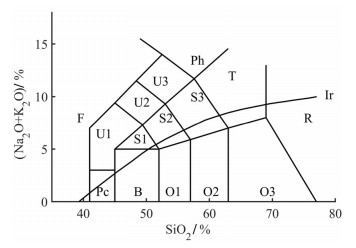
 下载:
下载:
